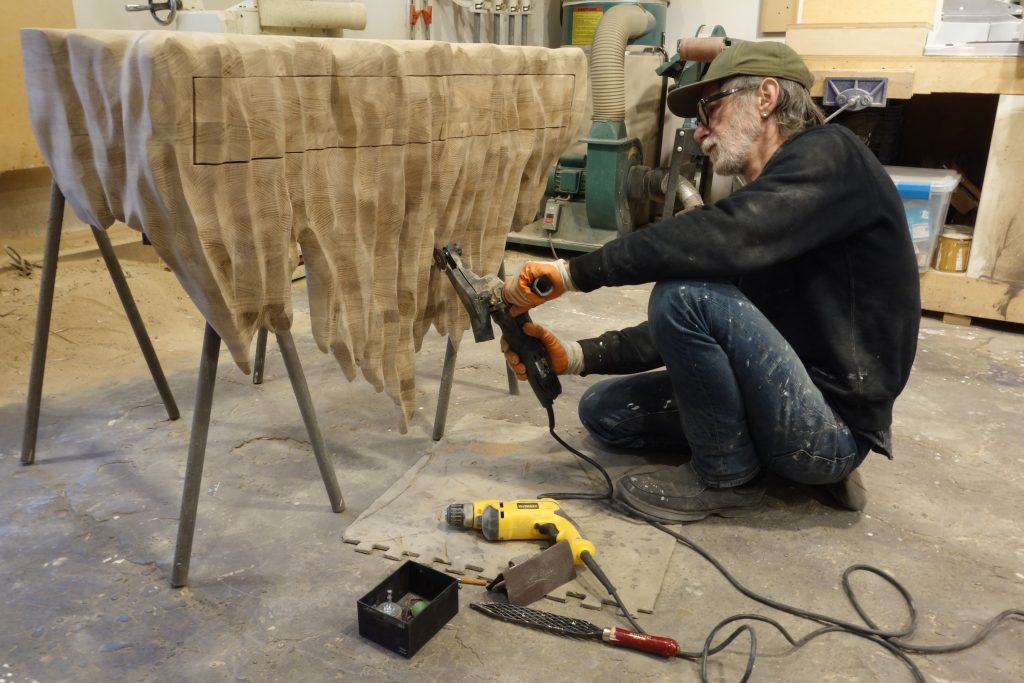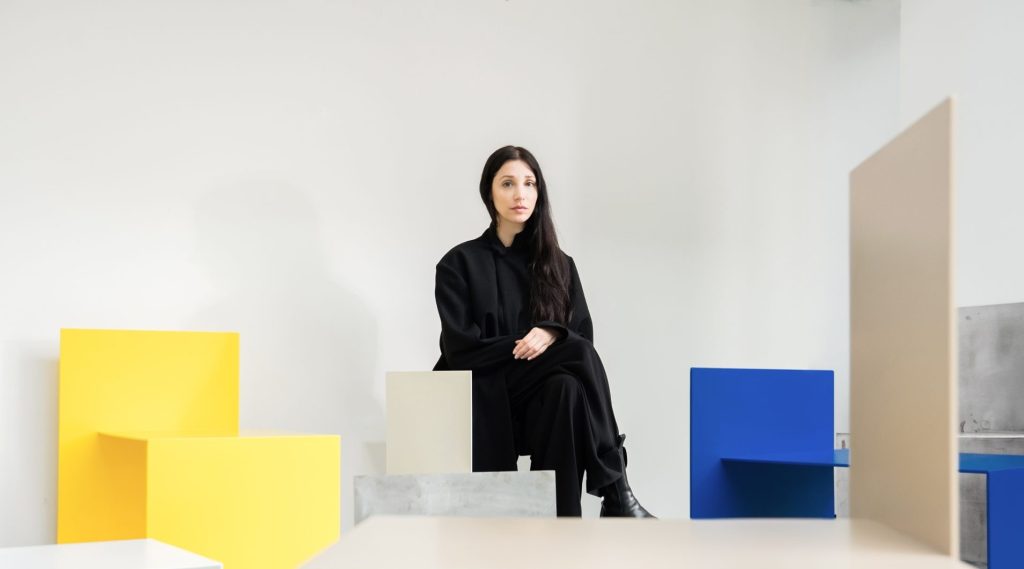
A. Vetra: Contemporary Collectible Objects with Ancient Mediterranean Memories
“As a designer, I want to create objects that evoke emotions and engage with people through their story or simply their tactile look and presence in space. As a craft enthusiast, I like to surround myself with objects that awaken memories and create an intimate and personal atmosphere.”
– Giulia Ferraris of A. Vetra
View A. Vetra’s showroom, including “Portafiori I”
History, identity, and craft intersect through an exploration of textile and ceramic in the work of A. Vetra, an Amsterdam-based studio established in 2019. Looking to ancient Mediterranean imagery and aesthetics, product and textile designer Giulia Ferraris creates timeless pieces within a narrative that speaks to contemporary audiences. Her pieces are imbued with history and memory, developing a connection between the past and present, the ancient and the modern. With her use of different design processes and media, Ferraris is able to investigate her own nostalgia for her home country of Italy in combination with the experimental approach of her chosen home in the Netherlands. In doing so, she constructs a unified aesthetic and identifiable narrative throughout her practice.
In A. Vetra’s most recent collections, “Portafiori” and “Volta”, Ferraris has worked closely with artisans in Italy and Nepal to highlight local craft knowledge and pay homage to ancient techniques and materials. Wool, linen, rattan, and clay offer a rich variety of texture and tactility in each piece. In “Volta”, soft golden hues mimic the palette of Mediterranean landscapes as architectural shapes are brought together using traditional Tibetan knot techniques. Classical forms of vessels used by ancient Greeks to collect and carry domestic goods are transformed in “Portafiori” (I, II, & III) through the use of alternative materials, with each form taking on a new role as collectible object. Through the use of these techniques and materials, Ferraris’ practice emphasises her interest in artisanal craftsmanship, her attention to the intricate details of handmade pieces, and the innate human connection developed between object and maker.
A. Vetra is a relatively recent endeavour, begun in 2019. What led you to develop this product and textile design practice?
I’ve always had a passion for pottery, fabrics, and handmade objects. Over the years, I’ve been collecting them in every shape, material, and origin – but the step towards a professional practice … started with a nostalgic feeling.
After studying at the Art School in the North of Italy, I attended an industrial design course. Shortly after that, after a brief time in Milan, I moved to Amsterdam where I worked in a textile design studio for five years. There, my passion for textiles strengthened and developed in a more technical way. Being immersed in a new cultural context made me value the environment I left. I’ve started to feel emotionally attracted to Mediterranean scenarios, a call back to something warmer and familiar.
That’s when A. Vetra started to take shape. I wanted to create tangible objects to convey a sense of connection with Mediterranean lands and celebrate [the] traditional craft techniques the territory is so rich [with].
More than a structured practice, I like to think of what I do as an exploration of what fascinates me, like texture, architecture, light play and shadows, and artisanal traditions. In every project I make space for a narrative, considering the shape as mutable within the story itself. Within this environment, I can create freely, and tactility is the common thread of my process. Today, I design ceramics and textile objects, but tomorrow I might be working on a new garment series or artwork.
As part of the “Healing Collection” at Virtual Design Destination 2020, how does your practice reflect and/or diverge from the contemporary Dutch design scene?
I believe my practice and contemporary Dutch design have a common interest and attraction to materials and their features, although I think the investigation and approach to these are quite different.
After living in the Netherlands for six years, I instinctively try to merge the Dutch innovative attitude with southern ways, based on tradition and know how. Charm for the past and interest in cultural heritage are deep inspirations for me and I always try to mix them with modern visions and new aesthetic approaches. Both scenes value the handmade: slow and patient methods, ruled by natural properties of the matter or specific technical developments. Repetitive gestures result in individual objects, unique in their imperfection and with a visible human trace.
The Dutch design I know is directed towards innovation and experimentation. Technical knowledge breaks boundaries and searches for new expressions and unexpected aesthetics. It is somehow spontaneous, rough, and flexible, with an analog approach and a hands-on attitude. Italian design is rooted in heritage. Considered en excellence for the artisanal abilities and the quality of the resources, it is mostly characterised by a symbiosis of craftsmanship and industrial processes, resulting in products with an individual story, deep knowledge of the craft, and strong material identity.
Through my practice, I try to merge the experience I have matured living, working, and experimenting in the Netherlands, with a more instinctive attraction to Mediterranean practices and traditional crafts.
A number of your pieces make reference to aesthetics and/or production methods from around the ancient Mediterranean. Which aspects of this period inspire your work the most? Why?
Many aspects of the Mediterranean culture belong to ancient origins. The Mediterranean was the basin where early civilizations were born and it is a connector of costumes, beliefs, and knowledge; [it is] a bridge from the past to the future. A multitude of crafts still in use today developed in those times. It is extremely exciting that every new project leads me to learn little pieces of our history.
The context I grew up in played an important role in shaping my personal style. I was raised in the outskirts of a Northern Italian city, home of famous architect and scenographer from the Renaissance, Andrea Palladio, and few steps away from a worldwide known ceramic district, Nove. Everywhere in Italy I feel surrounded by history and art; I admire and examine them. Observation became practice and point of reference for each project. I like to study the structure of architecture and how light shapes it, the pattern of arches inside churches, the palette of coloured facades, the composition of tiled floors, or the motif of embroidered tablecloths. I elaborate these inspirations into connotations and references that, together with an empathetic narrative, are the spine of my work.
Pieces like “Volta” and the “Portafiori” series place great importance on materiality and tactility. Why has this textural approach become an emphasis in your work?
When I look at volumes, shapes, or surfaces, I like to see how light and environment around them change their perception. I see tactile objects as moving textures, they [come] alive and capture my attention. Tactility is, for me, functional and emotional, it guides me through a story. Investigating this story can tell more about how things are made – about matter, forgotten abilities, unknown tales. Textures make me engage with the subject, I instinctively feel the need to get closer and touch them. I become curious and an active observer.
In my work, I apply the knowledge I gain about materials and processes to express tactile connotations. They are often the starting point of my explorations. Textures make me engage with territories and their heritage. Especially in Italy where each region is characterised by many artisanal districts, I find it extremely interesting that each of them specialised in a specific practice often rooted in old family traditions. I like to see the aesthetic of my pieces taking shape according to a certain craft procedure, a specific material, in a specific land. It develops in a dialogue where old ways are investigated with a more modern approach.
With reference to the distinctive narrative of cultural heritage and contemporary design in your pieces and imagery, how do you envision audiences reacting to/engaging with your practice?
My work conveys a fascination for the handmade and sentimentality for the past through Mediterranean aesthetics and craftsmanship. As a designer, I want to create objects that evoke emotions and engage with people through their story or simply their tactile look and presence in space. As a craft enthusiast, I like to surround myself with objects that awaken memories and create an intimate and personal atmosphere. Handcrafted pieces reminiscing of a warmer climate somehow dictate a slower pace, creating a familiar and timeless dimension. While designing, I try to envision my pieces into this imagery and that’s where I hope my vision meets the one of my audience.
Bio
A. Vetra is a project that explores the virtues of structures and materiality.
A. Vetra was founded in 2019 by Giulia Ferraris, an Italian multidisciplinary designer with a special attraction towards textile, tactility, and crafts. In her interdisciplinary exploration, traces of the past and modern visions engage in a tactile conversation, seeking a balance between our cultural heritage and contemporary aesthetic approaches.
As objects and textile editor, A.Vetra creates limited-edition collections and one-off pieces, praising the beauty of folk culture and Mediterranean imaginary through collaborations with artisanal identities.


















Responses